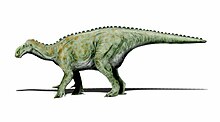The item you will receive is the item in the pictures provided above in this listing. Please view all the pictures to grade the item quality.
All of my items are genuine unless stated otherwise, so bid with confidence!
Please visit our ebay shop for great gift ideas including fossils, crystals & minerals!!
We will dispatch most items within 2 days of receiving payment, and I always combine shipping where possible on multiple purchases
Iguanodon were bulky herbivores that could shift from bipedality to quadrupedality. The only well-supported species, I. bernissartensis, is estimated to have weighed about 3.4 tons on average, and measured about 10 metres (33 feet) long as an adult, with some specimens possibly as long as 13 metres (43 feet) These animals had large, tall but narrow skulls, with toothless beaks probably covered with keratin, and teeth like those of iguanas, but much larger and more closely packed.
The arms of I. bernissartensis were long (up to 75% the length of the legs) and robust, with rather inflexible hands built so that the three central fingers could bear weight. The thumbs were conical spikes that stuck out away from the three main digits. In early restorations, the spike was placed on the animal's nose. Later fossils revealed the true nature of the thumb spikes, although their exact function is still debated. They could have been used for defense, or for foraging for food. The little finger was elongated and dextrous, and could have been used to manipulate objects. The legs were powerful, but not built for running, and each foot had three toes. The backbone and tail were supported and stiffened by ossified tendons.
Iguanodon teeth are, as the name suggests, like those of an iguana, but larger. Unlike hadrosaurids, which had columns of replacement teeth, Iguanodon only had one replacement tooth at a time for each position. The upper jaw held up to 29 teeth per side, with none at the front of the jaw, and the lower jaw 25; the numbers differ because teeth in the lower jaw are broader than those in the upper. Because the tooth rows are deeply inset from the outside of the jaws, and because of other anatomical details, it is believed that, as with most other ornithischians, Iguanodon had some sort of cheek-like structure, muscular or non-muscular, to retain food in the mouth
Any potential international import duties will be paid by the buyer, and may not be covered in the postage cost.
